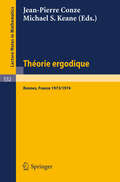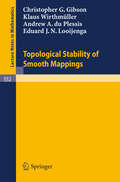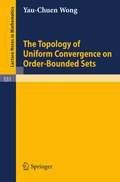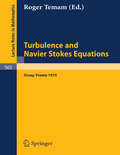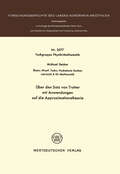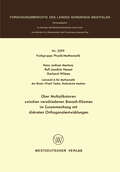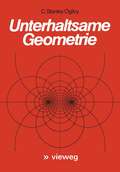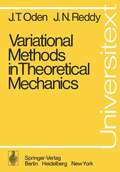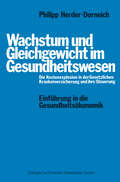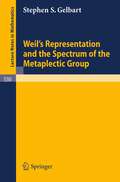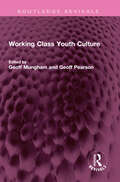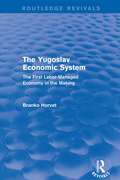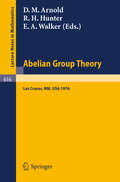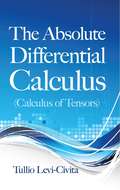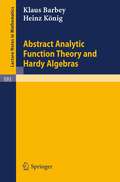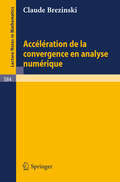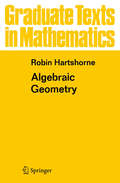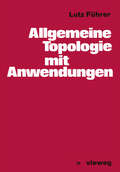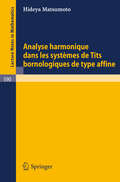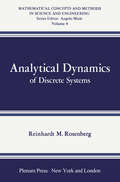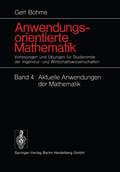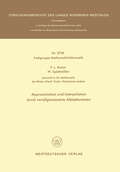- Table View
- List View
Theorie Ergodique: Actes des Journees Ergodiques, Rennes 1973/1974 (Lecture Notes in Mathematics #532)
by J. P. Conze M. S. KeaneTopological Stability of Smooth Mappings (Lecture Notes in Mathematics #552)
by C.G. Gibson K. Wirthmüller A.A. Du Plessis E.J.N. LooijengaThe Topology of Uniform Convergence on Order-Bounded Sets (Lecture Notes in Mathematics #531)
by Y.-C. WongTurbulence and Navier Stokes Equations: Proceedings of the Conference Held at the University of Paris-Sud, Orsay, June 12 - 13, 1975 (Lecture Notes in Mathematics #565)
by R. TemamÜber den Satz von Trotter mit Anwendungen auf die Approximationstheorie (Forschungsberichte des Landes Nordrhein-Westfalen #2577)
by Michael BeckerÜber Multiplikatoren zwischen verschiedenen Banach-Räumen: im Zusammenhang mit diskreten Orthogonalentwicklungen (Forschungsberichte des Landes Nordrhein-Westfalen #2599)
by Hans-Jochem MertensUnterhaltsame Geometrie
by C. Stanley OgilvyWas ist Geometrie? Eine junge Dame, so gefragt, antwortet ohne Zögern: "Oh, das ist das, wo etwas bewiesen wird." Gedrängt, ein Beispiel flir so ein zu beweisendes Etwas zu geben, mußte sie passen. Auch war ihr entgangen, warum es eine gute Sache war, etwas zu beweisen. Die Reaktion der Dame ist typisch für viele Menschen, die meinen, auf der Schule Geometrie gelernt zu haben. Sie vergessen alle die Hauptsache und ver gegenwärtigen sich nicht, warum dieser Stoff durchgenommen worden ist. Das Vergessen der Sätze ist keine Tragödie. Wir vergessen vieles von dem, was wir während unserer Schulzeit lernten - oder sollte ich sagen, was uns dort begegnete? Nichtsdesto weniger ist es bedauerlich, wenn ein ganzer Unterricht so langweilig ist, daß es nicht gelingt, irgendetwas daraus in dem Gedächtnis der Schüler einzuprägen. Zugegeben, die traditionelle Geometrie war selbst an diesem Mangel schuld (und ist es noch). Und warum wurde sie gelehrt? Weil man meinte, dem jungen Menschen ein einheitliches logisches System auf einem ihm gemäßen Niveau bieten zu müssen. Vermutlich erreichten einige Schüler das gewünschte Ziel, aber viele andere wurden so durch die Einzelheiten abge lenkt, daß sie den Blick für die Hauptsache verloren.
Variational Methods in Theoretical Mechanics (Universitext)
by J.T. Oden J.N. ReddyThis is a textbook written for use in a graduate-level course for students of mechanics and engineering science. It is designed to cover the essential features of modern variational methods and to demonstrate how a number of basic mathematical concepts can be used to produce a unified theory of variational mechanics. As prerequisite to using this text, we assume that the student is equipped with an introductory course in functional analysis at a level roughly equal to that covered, for example, in Kolmogorov and Fomin (Functional Analysis, Vol. I, Graylock, Rochester, 1957) and possibly a graduate-level course in continuum mechanics. Numerous references to supplementary material are listed throughout the book. We are indebted to Professor Jim Douglas of the University of Chicago, who read an earlier version of the manuscript and whose detailed suggestions were extremely helpful in preparing the final draft. He also gratefully acknowledge that much of our own research work on variational theory was supported by the U.S. Air Force Office of Scientific Research. He are indebted to Mr. Ming-Goei Sheu for help in proofreading. Finally, we wish to express thanks to Mrs. Marilyn Gude for her excellent and pains taking job of typing the manuscript. J. T. ODEN J. N. REDDY Table of Contents PREFACE 1. INTRODUCTION 1.1 The Role of Variational Theory in Mechanics. 1 1.2 Some Historical Comments ......... . 2 1.3 Plan of Study ............... . 5 7 2. MATHEMATICAL FOUNDATIONS OF CLASSICAL VARIATIONAL THEORY 7 2.1 Introduction . . . . . . . .
Wachstum und Gleichgewicht im Gesundheitswesen: Die Kostenexplosion in der Gesetzlichen Krankenversicherung und ihre Steuerung
by Philipp Herder-DorneichWeil's Representation and the Spectrum of the Metaplectic Group (Lecture Notes in Mathematics #530)
by Stephen S. GelbartWorking Class Youth Culture (Routledge Revivals)
First published in 1976, Working Class Youth Culture offers a much-needed alternative viewpoint to the law-and-order lobby which treats the youth question as a dreadful pest to be exterminated or caged in. The contributors describe the real conditions of life for working-class youth; how they make sense of the world; and how we can understand their perspective. The subjects discussed include Teddy Boys, Mods, Skinheads and the Glamrock Cult; dance-hall fights; picking up girls and going steady; how schools manufacture delinquency, truancy and vandalism; how working-class kids slide from bad schools to bad jobs, or to no jobs at all; Paki-bashing, racism and the competition over jobs and houses; how social change in post-war Britain has influenced youth culture; and how social scientists have hidden the real character of youth troubles behind the myth of a classless society. This book will be of interest to students of sociology and anthropology.
Working Class Youth Culture (Routledge Revivals)
by Geoff Mungham Geoff PearsonFirst published in 1976, Working Class Youth Culture offers a much-needed alternative viewpoint to the law-and-order lobby which treats the youth question as a dreadful pest to be exterminated or caged in. The contributors describe the real conditions of life for working-class youth; how they make sense of the world; and how we can understand their perspective. The subjects discussed include Teddy Boys, Mods, Skinheads and the Glamrock Cult; dance-hall fights; picking up girls and going steady; how schools manufacture delinquency, truancy and vandalism; how working-class kids slide from bad schools to bad jobs, or to no jobs at all; Paki-bashing, racism and the competition over jobs and houses; how social change in post-war Britain has influenced youth culture; and how social scientists have hidden the real character of youth troubles behind the myth of a classless society. This book will be of interest to students of sociology and anthropology.
The Yugoslav Economic System (Routledge Revivals): The First Labor-Managed Economy in the Making
by Branko HorvatFirst published in 1976, this book traces the development of the Yugoslav economy from the end of the Second World War to the beginning of 1975, which the author argues was a highly productive era of social innovation. Drawing on personal experience of the Revolution, the Partisan Liberation War and his time as a member of the Federal Planning Board as well as a comprehensive array of written sources, the author attempts to understand the development process, compare policy proclamations with achieved results, study the theories and ideas that led a to certain policy, distinguish the economic and political ingredients in decision making and analyses the causes of success and failure.
The Yugoslav Economic System (Routledge Revivals): The First Labor-Managed Economy in the Making
by Branko HorvatFirst published in 1976, this book traces the development of the Yugoslav economy from the end of the Second World War to the beginning of 1975, which the author argues was a highly productive era of social innovation. Drawing on personal experience of the Revolution, the Partisan Liberation War and his time as a member of the Federal Planning Board as well as a comprehensive array of written sources, the author attempts to understand the development process, compare policy proclamations with achieved results, study the theories and ideas that led a to certain policy, distinguish the economic and political ingredients in decision making and analyses the causes of success and failure.
Abelian Group Theory: Proceedings of the 2nd New Mexico State University Conference, held at LasCruces, New Mexico, December 9 - 12, 1976 (Lecture Notes in Mathematics #616)
by D. Arnold R. Hunter E. WalkerThe Absolute Differential Calculus: Calculus Of Tensors (Dover Books on Mathematics)
by Tullio Levi-CivitaWritten by a towering figure of twentieth-century mathematics, this classic examines the mathematical background necessary for a grasp of relativity theory. Tullio Levi-Civita provides a thorough treatment of the introductory theories that form the basis for discussions of fundamental quadratic forms and absolute differential calculus, and he further explores physical applications.Part one opens with considerations of functional determinants and matrices, advancing to systems of total differential equations, linear partial differential equations, algebraic foundations, and a geometrical introduction to theory. The second part addresses covariant differentiation, curvature-related Riemann's symbols and properties, differential quadratic forms of classes zero and one, and intrinsic geometry. The final section focuses on physical applications, covering gravitational equations and general relativity.
Abstract Analytic Function Theory and Hardy Algebras (Lecture Notes in Mathematics #593)
by K. Barbey H. KönigAcceleration de la convergence en analyse numerique (Lecture Notes in Mathematics #584)
by Claude BrezinskiAlgebraic Geometry (Graduate Texts in Mathematics #52)
by Robin HartshorneAn introduction to abstract algebraic geometry, with the only prerequisites being results from commutative algebra, which are stated as needed, and some elementary topology. More than 400 exercises distributed throughout the book offer specific examples as well as more specialised topics not treated in the main text, while three appendices present brief accounts of some areas of current research. This book can thus be used as textbook for an introductory course in algebraic geometry following a basic graduate course in algebra.Robin Hartshorne studied algebraic geometry with Oscar Zariski and David Mumford at Harvard, and with J.-P. Serre and A. Grothendieck in Paris. He is the author of "Residues and Duality", "Foundations of Projective Geometry", "Ample Subvarieties of Algebraic Varieties", and numerous research titles.
Analyse Harmonique dans les Systemes de Tits Bornologique de Type Affine (Lecture Notes in Mathematics #590)
by H. MatsumotoAnalytical Dynamics of Discrete Systems (Mathematical Concepts and Methods in Science and Engineering)
by R. RosenbergThis book is to serve as a text for engineering students at the senior or beginning graduate level in a second course in dynamics. It grew out of many years experience in teaching such a course to senior students in mechanical engineering at the University of California, Berkeley. While temperamentally disinclined to engage in textbook writing, I nevertheless wrote the present volume for the usual reason-I was unable to find a satisfactory English-language text with the content covered in my inter mediate course in dynamics. Originally, I had intended to fit this text very closely to the content of my dynamics course for seniors. However, it soon became apparent that that course reflects too many of my personal idiosyncracies, and perhaps it also covers too little material to form a suitable basis for a general text. Moreover, as the manuscript grew, so did my interest in certain phases of the subject. As a result, this book contains more material than can be studied in one semester or quarter. My own course covers Chapters 1 to 5 (Chapters 1,2, and 3 lightly) and Chapters 8 to 20 (Chapter 17 lightly).
